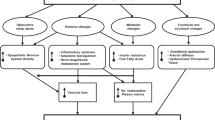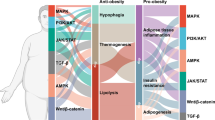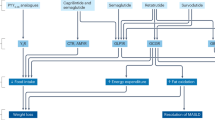Abstract
Obesity greatly increases risk of cardiovascular disease, metabolic syndrome, and diabetes mellitus. Most obese patients are unable to sustain appreciable weight loss; the body has a natural tendency to return to its previous weight. Although bariatric surgery is effective, it is not without risk. Until better treatments for obesity are available, management remains focused on lifestyle changes, drug therapy, and treating the metabolic complications of obesity. The main cause of metabolic dysfunction in obesity is visceral fat. Fat deposition in and around organs, skeletal muscle, and other tissues is thought to occur when subcutaneous adipose tissue stores are full. Creation of additional adipose-tissue stores is prevented by the mature adipocytes, which inhibit the differentiation of preadipocytes in a negative feedback loop. This inhibition is mediated, in part, by the renin–angiotensin system. Indeed, angiotensin II blockade has been shown to promote adipogenesis in vitro. Clinical studies are currently underway to investigate whether the angiotensin-II-receptor blocker telmisartan can stimulate adipogenesis, with the aim of diverting intramuscular fat back into adipose tissue and thereby restoring insulin sensitivity. If this effect can be demonstrated in humans, this type of agent might become the treatment of choice for obese or overweight people at risk of type 2 diabetes.
Key Points
-
Obesity is a complex disorder that is difficult to control because various biological and environmental factors promote weight gain and regain
-
Although lifestyle changes have traditionally been the cornerstone of obesity management, weight loss is difficult to maintain in the long term
-
Matching the choice of intervention with lifestyle changes, pharmacotherapy, surgical approaches, or a combination of these, to the degree of adiposity seems to improve treatment success
-
Angiotensin II blockade with telmisartan might reduce the amount of intramuscular fat deposition and improve blood pressure control in obese patients
This is a preview of subscription content, access via your institution
Access options
Subscribe to this journal
Receive 12 print issues and online access
$209.00 per year
only $17.42 per issue
Buy this article
- Purchase on Springer Link
- Instant access to full article PDF
Prices may be subject to local taxes which are calculated during checkout





Similar content being viewed by others
References
Yusuf S et al. (2005) Obesity and the risk of myocardial infarction in 27,000 participants from 52 countries: a case-control study. Lancet 366: 1640–1649
Franzosi MG (2006) Should we continue to use BMI as a cardiovascular risk factor? Lancet 368: 624–625
Stevens J et al. (1998) The effect of age on the association between body-mass index and mortality. N Engl J Med 338: 1–7
Despres JP et al. (1990) Regional distribution of body fat, plasma lipoproteins, and cardiovascular disease. Arteriosclerosis 10: 497–511
Sharma AM et al. (2002) Adipose tissue: a mediator of cardiovascular risk. Int J Obesity 26 (Suppl 4): S5–S7
National Cholesterol Education Program (2002) Third Report of the National Cholesterol Education Program (NCEP) Expert Panel on Detection, Evaluation, and Treatment of High Blood Cholesterol in Adults (Adult Treatment Panel III) final report. Circulation 106: 3143–3421
Katzmarzyk PT (2002) The Canadian obesity epidemic, 1985-1998. CMAJ 166: 1039–1040
Martorell R et al. (2000) Obesity in women from developing countries. Eur J Clin Nutr 54: 247–252
Mokdad AH et al. (2003) Prevalence of obesity, diabetes, and obesity-related health risk factors, 2001. JAMA 289: 76–79
Wyatt SB et al. (2006) Overweight and obesity: prevalence, consequences, and causes of a growing public health problem. Am J Med Sci 331: 166–174
Haslam DW and James WP (2005) Obesity. Lancet 366: 1197–1209
Wynne K et al. (2005) Appetite control. J Endocrinol 184: 291–318
Levin BE (2005) Factors promoting and ameliorating the development of obesity. Physiol Behav 86: 633–639
MacLean PS et al. (2004) Metabolic adjustments with the development, treatment, and recurrence of obesity in obesity-prone rats. Am J Physiol Regul Integr Comp Physiol 287: R288–R297
Elfhag K and Rossner S (2005) Who succeeds in maintaining weight loss? A conceptual review of factors associated with weight loss maintenance and weight regain. Obes Rev 6: 67–85
Leibel RL et al. (1995) Changes in energy expenditure resulting from altered body weight. N Engl J Med 332: 621–628
Lakka TA and Bouchard C (2005) Physical activity, obesity and cardiovascular diseases. Handb Exp Pharmacol 170: 137–163
Merchant A et al. (2006) A cardiologist's guide to waist management. Heart 92: 865–866
Stevens VJ et al. (2001) Long-term weight loss and changes in blood pressure: results of the Trials of Hypertension Prevention, phase II. Ann Intern Med 134: 1–11
Lindstrom J et al. (2003) The Finnish Diabetes Prevention Study (DPS): Lifestyle intervention and 3-year results on diet and physical activity. Diabetes Care 26: 3230–3236
Knowler WC et al. (2002) Reduction in the incidence of type 2 diabetes with lifestyle intervention or metformin. N Engl J Med 346: 393–403
Latner JD (2001) Self-help in the long-term treatment of obesity. Obes Rev 2: 87–97
Crookes PF (2006) Surgical treatment of morbid obesity. Annu Rev Med 57: 243–264
Buchwald H et al. (2004) Bariatric surgery: a systematic review and meta-analysis. JAMA 292: 1724–1737
Halford JC (2006) Pharmacotherapy for obesity. Appetite 46: 6–10
Wadden TA et al. (2005) Randomized trial of lifestyle modification and pharmacotherapy for obesity. N Engl J Med 353: 2111–2120
James WPT (2005) The SCOUT study: risk–benefit profile of sibutramine in overweight high-risk cardiovascular patients. Eur Heart J Suppl 7 (Suppl L): L44–L48
Curioni C et al. (2006) Rimonabant for overweight or obesity. The Cochrane Database of Systematic Reviews, Issue 4, Art. No CD006162, doi:10.1002/14651858.CD006162.pub2
Iacobellis G et al. (2003) Relationship of insulin sensitivity and left ventricular mass in uncomplicated obesity. Obes Res 11: 518–524
Manco M et al. (2000) Insulin resistance directly correlates with increased saturated fatty acids in skeletal muscle triglycerides. Metabolism 49: 220–224
Mingrone G et al. (2002) Skeletal muscle triglycerides lowering is associated with net improvement of insulin sensitivity, TNF-alpha reduction and GLUT4 expression enhancement. Int J Obes Relat Metab Disord 26: 1165–1172
Cree MG et al. (2004) Intramuscular and liver triglycerides are increased in the elderly. J Clin Endocrinol Metab 89: 3864–3871
Heilbronn L et al. (2004) Failure of fat cell proliferation, mitochondrial function and fat oxidation results in ectopic fat storage, insulin resistance and type II diabetes mellitus. Int J Obes Relat Metab Disord 28 (Suppl 4): S12–S21
Sharma AM et al. (2002) Angiotensin blockade prevents type 2 diabetes by formation of fat cells. Hypertension 40: 609–611
Janke J et al. (2002) Mature adipocytes inhibit in vitro differentiation of human preadipocytes via angiotensin type 1 receptors. Diabetes 51: 1699–1707
Ailhaud G et al. (2000) Angiotensinogen, angiotensin II and adipose tissue development. Int J Obes Relat Metab Disord 24 (Suppl 4): S33–S35
Weber M (2003) The telmisartan Programme of Research tO show Telmisartan End-organ proteCTION (PROTECTION) programme. J Hypertens Suppl 21: S37–S46
Sharma AM et al. (2005) Comparison of the antihypertensive efficacy of telmisartan/hydrochlorothiazide vs valsartan/hydrochlorothiazide in high-risk overweight/obese patients with hypertension and type 2 diabetes [abstract #PC.11]. Hypertension 46: 898–899
Acknowledgements
PAREXEL MMS provided writing assistance, comprising preparation of a draft from slides and audio transcript, preparation of figures and obtaining copyright permissions, proofreading, and reference checking.
Author information
Authors and Affiliations
Ethics declarations
Competing interests
The author declares no competing financial interests.
Rights and permissions
About this article
Cite this article
Sharma, A. The value of current interventions for obesity. Nat Rev Cardiol 5 (Suppl 1), S3–S9 (2008). https://doi.org/10.1038/ncpcardio0854
Received:
Accepted:
Issue Date:
DOI: https://doi.org/10.1038/ncpcardio0854
This article is cited by
-
Vagus Nerve Stimulation Improves Cardiac Function by Preventing Mitochondrial Dysfunction in Obese-Insulin Resistant Rats
Scientific Reports (2016)
-
Identification of cardiovascular genes in omentum from morbidly obese patients with type 2 diabetes
International Journal of Obesity (2010)
-
A 4-year, cluster-randomized, controlled childhood obesity prevention study: STOPP
International Journal of Obesity (2009)



